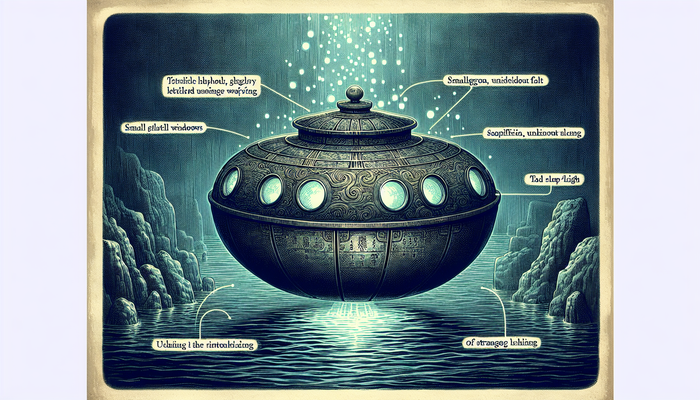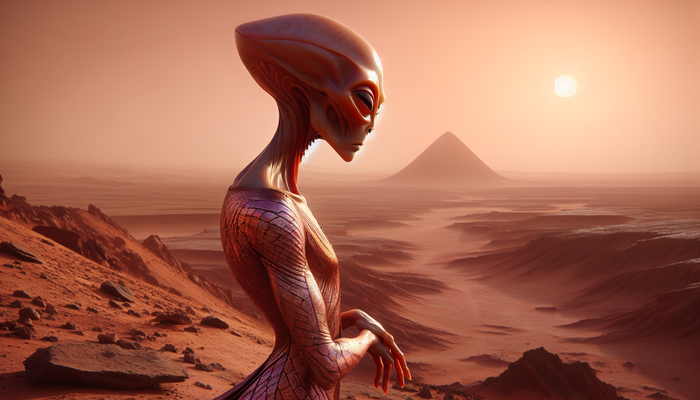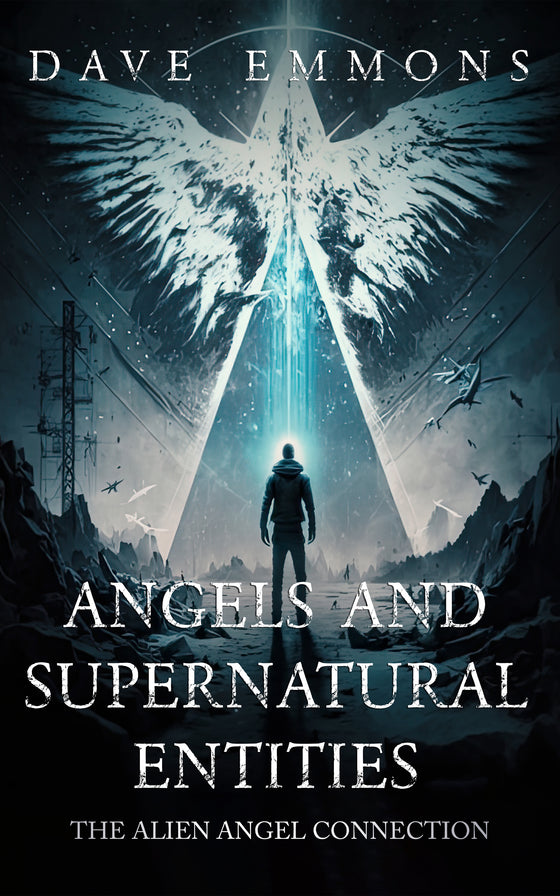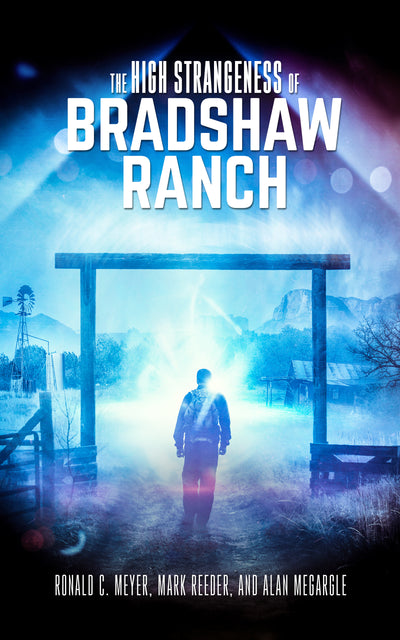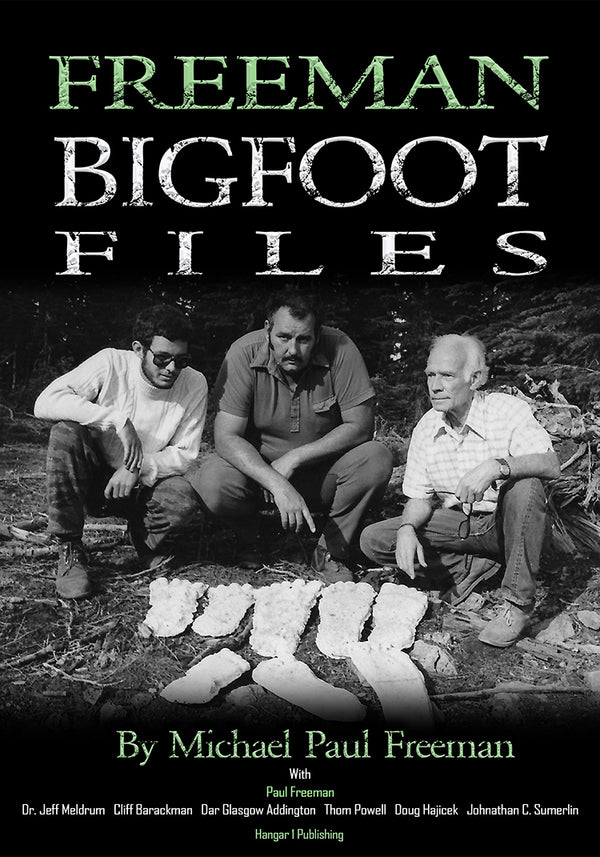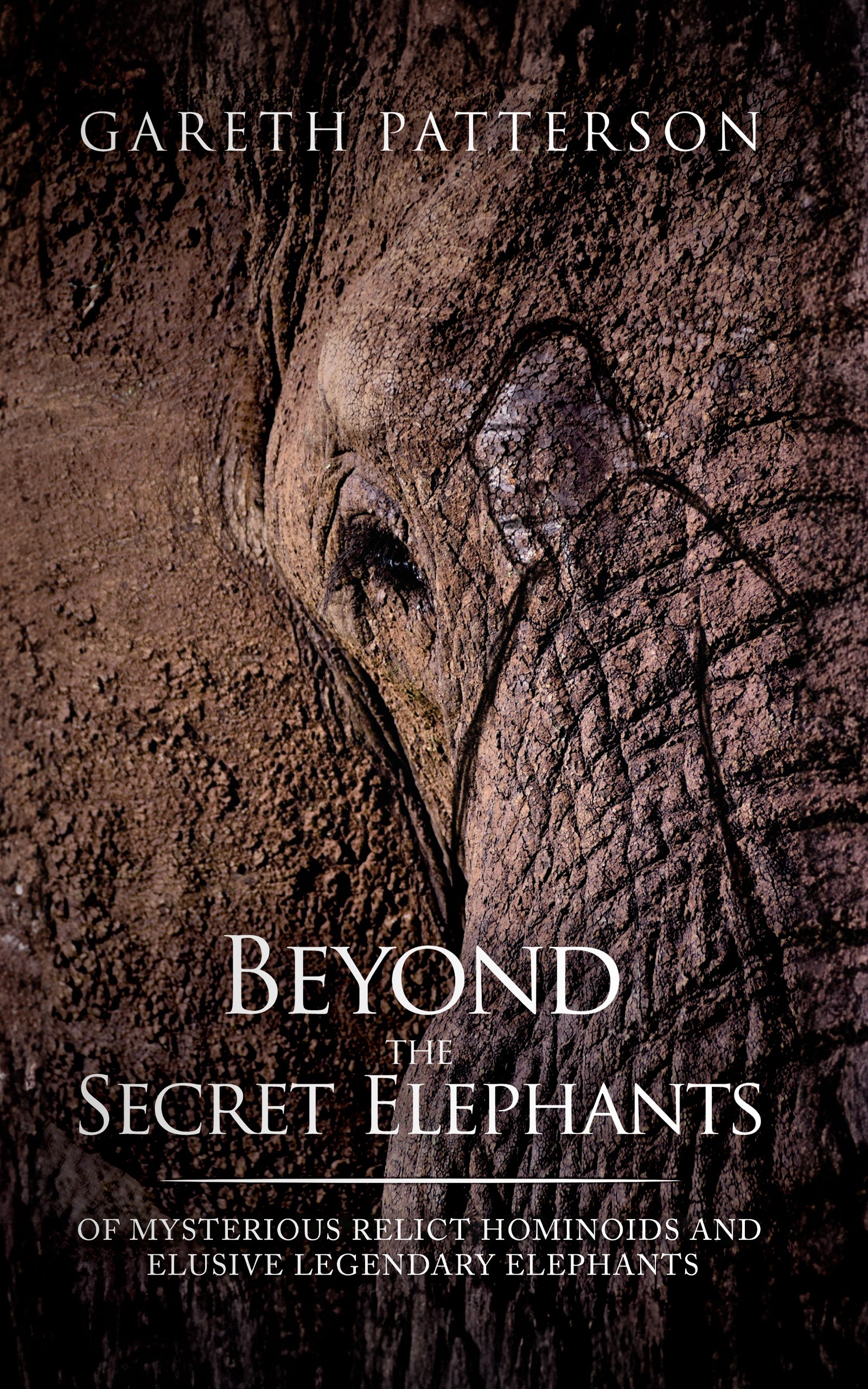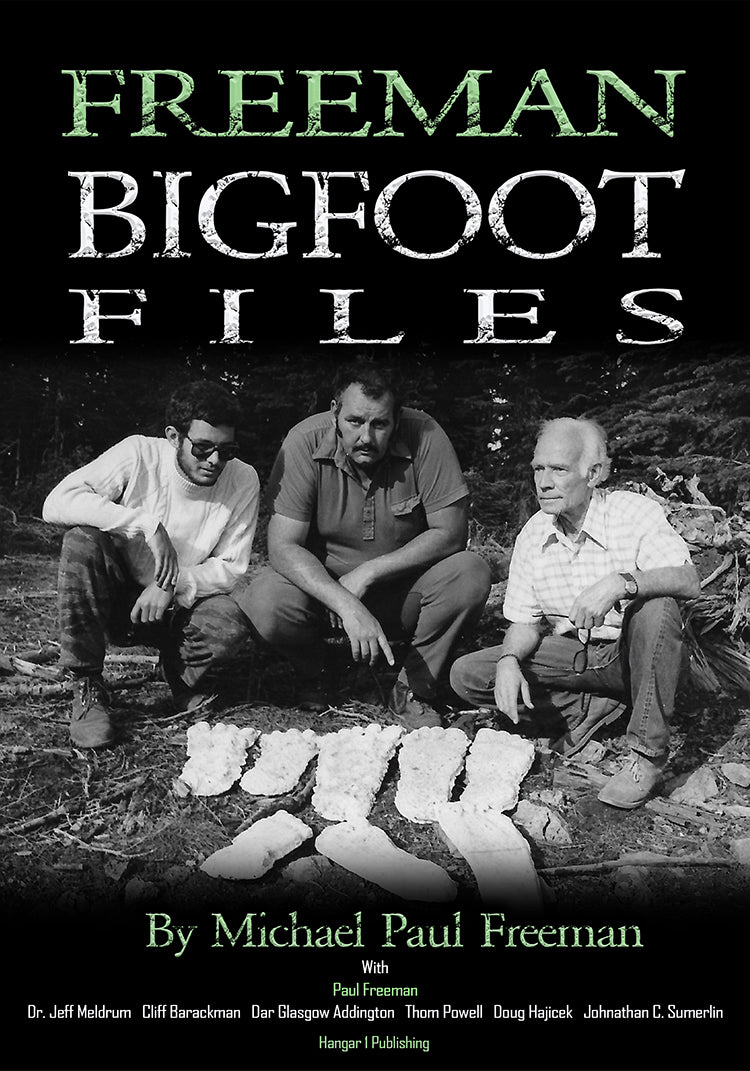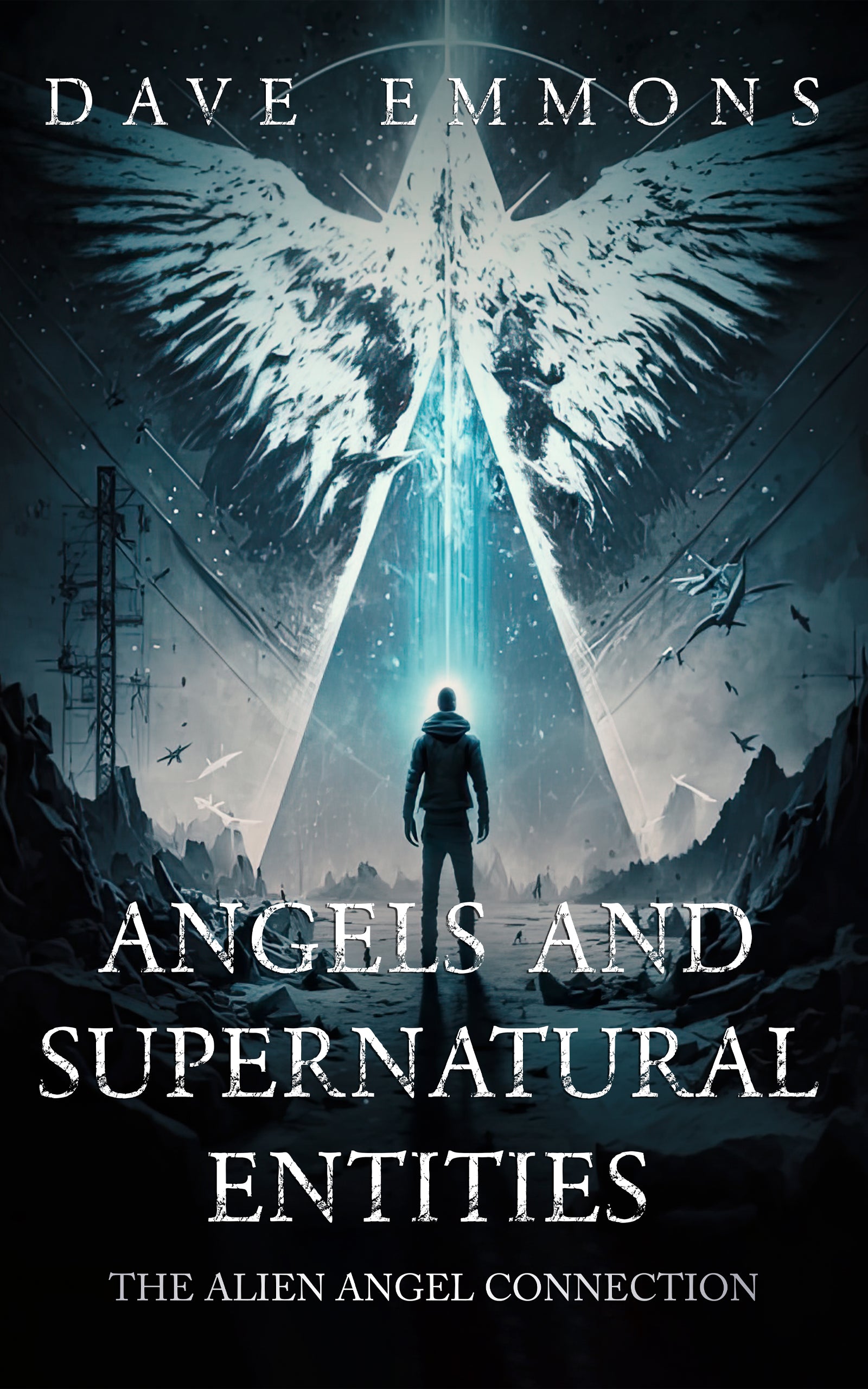Vedic UFO References: Ancient Flying Machines & Alien Theories

By Amara Okafor, Ufologist
Could the skies of ancient India have been more crowded than we could ever imagine? Not with birds, but with craft that might make our modern aerospace engineers raise their eyebrows in astonishment. When Pentagon officials recently acknowledged that UFOs (or UAPs - Unidentified Aerial Phenomena) are real, they confirmed what some researchers of ancient Indian texts have been suggesting for decades: the possibility that sophisticated flying machines have been visiting Earth for thousands of years.
The apparent technological disconnect seems impossible at first glance. How could civilizations from thousands of years ago describe technologies that appear beyond our current capabilities? Yet the references exist-detailed accounts of self-propelled aerial vehicles, devastating weapons of immense power, and beings from other worlds or planes of existence.
In this article, I'll explore the fascinating references within Vedic literature that point to ancient flying machines called Vimanas and interactions with non-terrestrial beings. We'll examine textual descriptions, potential technological parallels, interpretations of deities as extraterrestrials, and the philosophical framework that might make sense of it all.
Prepare to journey through ancient epics and forgotten technologies – a journey that might just redefine our understanding of ancient history and the cosmos itself.
Unveiling the Vimanas: Ancient Flyers in the Vedic Sky
Defining the "Vimana": More Than Just a Word
The term "Vimana" carries multiple meanings in Sanskrit, originating from roots that suggest "measuring out" or "traversing." Far from being a simple descriptor, it encompasses concepts of temples, palaces, and most intriguingly, flying machines.
What I find particularly fascinating is that in many modern Indian languages, the word directly translates to "aircraft." Bangladesh's national airline is even called "Biman," and there are places named Vimanapura (a suburb of Bangalore) and Vimannagar (a town in Pune). This linguistic connection spanning millennia suggests that the concept has maintained relevance throughout Indian cultural history.
Vimanas weren't just abstract concepts or isolated mentions. They appear across numerous texts, described as diverse types of aerial vehicles with varying capabilities and designs. This consistency across different works suggests they were an established concept in ancient Indian thought, not merely fanciful inventions.
The Legendary Pushpaka Vimana: A Case Study in Ancient Aeronautics
The most celebrated Vimana in ancient Indian literature is undoubtedly the Pushpaka ("flowery") Vimana featured prominently in the epic Ramayana. Its ownership history is detailed with remarkable precision: crafted by Vishwakarma (the divine architect) for Brahma (the creator god), then given to Kubera (god of wealth), before being stolen by his half-brother Ravana (the demon king of Lanka).
The Ramayana's descriptions of this vehicle are surprisingly technical:
"The Pushpaka Vimana that resembles the Sun and belongs to my brother was brought by the powerful Ravana; that aerial and excellent Vimana going everywhere at will... that chariot resembling a bright cloud in the sky... and the King [Rama] got in, and the excellent chariot at the command of the Raghira, rose up into the higher atmosphere."
Other passages describe it as "shining like the sun," "making a noise like the roaring of clouds," and "defying all obstacles." It was reportedly large, with multiple stories, numerous chambers with windows, adorned with flags and banners.
One of its most remarkable reported features was its capacity - it supposedly always had one seat vacant regardless of how many passengers boarded. When Lord Rama asked to bring an entire army home in the Pushpaka, Vibhishan simply told him it could accommodate as many people as he wished. This suggests an almost adaptive or intelligent design that goes beyond simple mechanical engineering.
In Sri Lanka, local traditions refer to the Pushpaka as "Dhandu Monara" (the Flying-Peacock), and there's even a location called Weragantota, meaning "landing place of aircraft," considered one of Ravana's airports. Nearby Gurulupotha ("parts-of-birds") is said to have housed an aircraft repair center. These geographical connections suggest that, at minimum, the concept of flying machines was integrated deeply enough into the culture to leave lasting impressions on place names.
Vimanas Beyond the Pushpaka: A Fleet Across the Texts
The Pushpaka is far from the only Vimana mentioned in ancient Indian texts. The Mahabharata contains numerous references to aerial vehicles used in warfare, describing them as capable of operating in multiple environments:
"When the Daityas were being slaughtered they again took to their vimana and, employing the Danava science, flew up into the sky... I (Arjuna) assaulted their vimana... Wounded by the flight of deadly-accurate iron missiles, the Asura vimana fell broken to the earth..."
This passage not only mentions the Vimanas' aerial capabilities but also suggests they employed a specific "science" and could be damaged by weapons, indicating a physical rather than purely mystical nature.
When Arjuna visited heaven, he "beheld celestial cars by thousands stationed in their respective places and capable of going everywhere at will, and he saw tens of thousands of such cars moving in every direction!"
The Rigveda, among the oldest known texts, contains earlier references to flying chariots pulled by animals, such as horses (agnihotra-vimana with fire engines) and even elephants (gaja-vimana). Interestingly, later texts around 500 BCE describe self-moving aerial cars without animal propulsion, suggesting either an evolution in the technology or in the understanding of it.
Jain literature also mentions various Vimanas used by their Tirthamkaras (spiritual leaders). The 24th Tirthamkara Mahavira is said to have emerged from the "great vimana Pushpa-uttara," while the 4th and 5th Tirthamkaras traveled through the sky in the "Jayanta-vimana."
A fascinating historical note comes from the edicts of Emperor Ashoka (3rd century BCE), which mention a model Vimana as part of festivals, suggesting these concepts were recognized elements of culture, whether literal or symbolic.
The Vaimanika Shastra: A Twentieth-Century Treatise on Ancient Flight?
The Enigma of the Source
When discussing ancient Indian flying machines, the Vaimanika Shastra inevitably enters the conversation, though with significant controversy. This text wasn't discovered in ancient ruins or preserved in ancient libraries. Instead, it was dictated by Pandit Subbaraya Shastry between 1918-1923, who claimed to have received the knowledge through psychic channeling with the ancient sage Bharadvaja.
Shastry's personal story adds layers of intrigue to the text's origins. He reportedly contracted leprosy and spent nine years living in isolation in a forest, during which time he communicated with Bharadvaja. Upon returning, cured of his disease, he couldn't write or read, so he dictated the information 25 years after his mystical experience. The text was discovered in 1952 by G.R. Josyer, who translated it into English in 1973.
It's worth noting that mercury, which features prominently in the described propulsion systems, was historically used as a treatment for leprosy. This connection has led some skeptics to suggest that Shastry's descriptions might have been influenced by his medical experiences rather than ancient knowledge.
Detailed Descriptions and Bold Claims
Despite questions about its authenticity, the Vaimanika Shastra presents remarkably detailed content: 3,000 shlokas (verses) spread across eight chapters, with comprehensive information about constructing and operating Vimanas.
The text makes extraordinary claims about the capabilities of these aircraft:
- Construction techniques for building planes that won't break, catch fire, or be destroyed
- Methods for making planes motionless (hovering)
- Techniques for achieving invisibility (stealth)
- Systems for capturing photographs of the interior of enemy planes (intelligence gathering)
- Methods for determining the direction of approaching enemy aircraft (similar to radar)
- Weapons that could make persons in enemy planes lose consciousness
- Techniques for destroying enemy aircraft
These capabilities mirror many features reported in modern UFO sightings, including hovering, rapid directional changes, apparent invisibility or cloaking, and the ability to detect and respond to other aircraft.
Propulsion Puzzles: The Mercury Vortex Engine and Beyond
One of the most intriguing aspects of the Vaimanika Shastra is its description of propulsion systems, particularly the mercury vortex engine. According to the text, this engine used the "power latent in mercury" to create movement.
This concept appears in other texts as well. The Samarangana Sutradhara, an 11th-century treatise on architecture by King Bhoja, contains a similar description:
"Inside the circular air frame, place the mercury-engine with its electric/ultrasonic mercury boiler at the bottom center. By means of the power latent in the mercury which sets the driving whirlwind in motion, a man sitting inside may travel a great distance in the sky in a most marvelous manner."
The text continues to describe how four mercury containers built into the interior structure, when heated by controlled fire from iron containers, would develop "thunder-power" that would make the Vimana like "a pearl in the sky."
Other propulsion methods mentioned include a yellowish-white liquid (possibly resembling gasoline), combustion engines, and even "pulse-jet" engines. This variety suggests either multiple technologies developed over time or diverse interpretations of similar concepts.
Skepticism and Scientific Scrutiny
In 1974, researchers from the aeronautical and mechanical engineering departments at the Indian Institute of Science conducted a study of the Vaimanika Shastra. Their conclusion was not favorable to proponents of ancient advanced technology. They described the machines as "poor concoctions" and deemed them unfeasible for flight.
The researchers noted that the text did not adequately explain how the Vimanas would get airborne in the first place, and that the author appeared to have some knowledge of modern machinery (modern for the early 1900s) but little understanding of aeronautics. The illustrations based on the text more closely resembled fantastical "steampunk flying machines" than viable aircraft.
This scientific assessment casts doubt on the Vaimanika Shastra's claim to represent ancient technology. However, proponents argue that the text might preserve fragments or misunderstood elements of genuine ancient knowledge, filtered through the understanding available to Shastry in the early 20th century.
The Enduring Influence
Despite questions about its authenticity, the Vaimanika Shastra has had a profound impact on discussions of ancient technology and potential extraterrestrial influences in human history.
What's particularly interesting is that NASA and other research organizations actually did experiment with ion propulsion using mercury in the 1970s, though they later abandoned it due to the element's toxicity in favor of safer xenon gas. Some proponents point to this as evidence that ancient knowledge might have inspired modern research, though the connection remains speculative at best.
These experiments by NASA in the 1970s may have fueled the legend that NASA was trying to build space vehicles inspired by ancient mercury vortex engines, creating a curious feedback loop between ancient texts, modern interpretation, and cutting-edge space technology.
Beyond the Machines: Celestial Beings and Ancient Alien Theories
Deities as Visitors: Reinterpreting the Divine
The ancient alien theory suggests that Hindu deities weren't supernatural beings but advanced extraterrestrial visitors who influenced early human civilization. Through this lens, their extraordinary abilities and advanced technologies weren't divine powers but scientific achievements beyond the comprehension of ancient humans.
Consider Lord Vishnu, who is described as descending to Earth in various avatars, often arriving in celestial vehicles. Some theorists interpret the Shiva Lingam, traditionally a sacred symbol, as representing an ancient energy device or spacecraft. These reinterpretations transform religious narratives into potential accounts of extraterrestrial contact.
Dr. V. Raghavan, former head of Sanskrit at the University of Madras, lent academic weight to these theories, stating: "Fifty years of researching these ancient works convinces me that there are living beings on other planets, and that they visited earth as far back as 4,000 BC."
A Pantheon of Possibilities: Diverse Beings from Other Realms
Hindu texts describe a remarkably diverse array of non-human entities. A Reddit user who studied Hindu texts notes references to beings called "Yaksha, Gandharva, Daitya, Danav, Rakshas, Nagas, Devas, Asuras, Ganas of the devas, Dakini, Shakini, Vanar and more."
What's particularly interesting is how these beings are characterized. Unlike the strict good/evil dichotomy often found in Western religious traditions, Hindu texts present these entities as species similar to humans in their behavioral complexity - some factions friendly, others dangerous, each acting according to their own interests and situations.
Research on Sanskrit texts in Vedic Scriptures identifies taxonomies of extraterrestrial beings based on dominant qualities (gunas), physiology and origin, realms of existence, and even chemical compounds that form their molecular basis.
The reptilian species (Rudranas), for instance, include the Nagas and Uragas clans, who historically interacted with humans. The Mahabharata records that Arjuna married Ulupi, a Naga princess, suggesting integration between these species and humans. Meanwhile, Pakshinas (avian species) are described as residing on a planetary cluster called Kinnaraloka, having wings and feathers but also the ability to think and speak like humans.
The Cosmic Battlefield: Advanced Warfare in the Epics
The Mahabharata describes warfare involving weapons of devastating power that bear striking resemblances to modern armaments. The Brahmastra, often compared to nuclear weapons, could destroy entire cities. The epic describes it as creating "an incandescent column of smoke and fire, as brilliant as ten thousands suns" that "reduced to ashes the entire race of the Vrishnis and Andhakas."
Even more telling are the described aftermath effects - corpses so burned they were unidentifiable, survivors suffering hair and nail loss - symptoms remarkably similar to radiation exposure.
"Indra's Dart" operated via a circular "reflector" that produced a "shaft of light" capable of consuming any target with its power - reminiscent of modern directed energy weapons. Krishna, pursuing his enemy Salva in an aerial battle, used special weapons that could "kill by seeking out sound" when Salva's vehicle became invisible.
In the Bhagavata Purana, a particularly detailed account describes King Salva's "flying iron city" called Saubha, given to him by Maya Danava. This aerial vehicle could appear in multiple identical forms one moment and as a single craft the next, sometimes visible and sometimes not. "From one moment to the next the Saubha airship appeared on the earth, in the sky, on a mountain peak or in the water. Like a whirling, flaming baton, it never remained in any one place."
The battle strategies described - invisibility, multiplication of craft, rapid position changes - mirror tactics discussed in modern UFO literature and reported military encounters. These accounts aren't isolated to Hindu texts. Similar descriptions appear in other ancient civilizations, suggesting either a shared historical experience or widespread cultural exchange.
The Cosmic Landscape: Lokas, Dimensions, and Interstellar Travel
The Fourteen Lokas: A Multidimensional Universe
The Vedic cosmology presents a universe far more complex than a single planet orbiting a star in empty space. Instead, it describes a multidimensional cosmos divided into fourteen Lokas or planetary systems - seven higher (Urdhva-loka), Earth in the middle (Bhu-loka or Madhya-loka), and seven lower (Adho-loka).
Each Loka represents different planes of existence with unique properties and inhabitants. This sophisticated cosmology bears similarities to modern theories of multiple dimensions or parallel universes.
The blog "Decode Hindu Mythology" presents a fascinating breakdown of these Lokas, depicting them as a hierarchical arrangement with Earth (Bhu Mandala) in the middle. The higher Lokas include Satya-loka (abode of Brahma), Tapo-loka (home of the four Kumars), Jana-loka, Mahar-loka (inhabited by great sages), Svarga-loka (heaven of the 33 Vedic gods), Bhuvar-loka (corresponding roughly to our solar system), and intermediate regions.
By definition, the denizens of these other Lokas would be "aliens" - intelligent beings not originating on Earth. The texts describe their interactions with humans matter-of-factly, not as extraordinary events but as part of the cosmic order.
Advanced Civilizations Beyond Earth
The descriptions of these other Lokas and their inhabitants present a picture of advanced civilizations with technologies far beyond those available to ancient humans. The residents of Svarga-loka (heaven), for instance, are described as having "unimaginable riches, wish-fulfilling trees, supersonic space-crafts, ability to travel in different dimensions, long life-spans, and freedom from disease and disability."
The lower worlds, paradoxically, are described as even more materially advanced than the higher ones. The Bhagavata Purana states that the bila-svargas (subterranean heavens) are dark planets without sunlight but artificially lit "by means of huge reflecting surfaces in the form of crystals and gems." Their inhabitants "bathe in elixirs which free them from anxiety or physical disease, as well as any signs of physical aging." Their cities feature "incredible feats of architecture" adorned with valuable jewels.
These descriptions suggest advanced knowledge of materials science, medicine, energy production, and environmental engineering - technologies that would indeed appear magical to ancient humans without similar capabilities.
Battles Across the Realms: Evidence of Interplanetary Conflict
The research materials reference interplanetary warfare, particularly between Devas (gods) and Asuras (demons), suggesting conflicts between different extraterrestrial species. One account describes a battle at the port city of Dwarka, where a king named Salva attacked using his "flying iron city" called Saubha.
A particularly fascinating account involves the Tripurasura - three floating cities belonging to Asuras that could only be destroyed when they aligned perfectly. This rare alignment suggests a description of orbiting structures or satellites requiring precise positioning for a successful attack.
When the alignment occurred, Lord Shiva destroyed all three cities simultaneously with a powerful weapon called the Narayanastra. The event was considered so significant that it generated its own holiday, Dev Deepavali, celebrated two weeks after the regular Deepavali festival.
"The smallest fraction of time when these three cities are aligned or these three satellites are aligned that's when Shiva shoots the Narayana and it's a grand description... Shiva has Bhoomi as a chariot, the sun and the moon are the wheels of The Chariot, and he takes Mount Meru as a bow and from there he shoots the Narayanastra to destroy these in one single explosion."
This account combines elements of astronomy, orbital mechanics, and weapons of mass destruction in a way that suggests either remarkable imagination or observation of actual events beyond the technological capabilities normally attributed to ancient civilizations.
Interstellar Travel in Ancient Texts
The Vedic texts contain numerous references to interstellar travel. The Bhagavata Purana describes beings traveling between planets in Vimanas:
"Having spoken thus, Maharaja Nriga circumambulated Lord Krishna and touched his crown to the Lord's feet. Granted permission to depart, King Nriga then boarded a wonderful celestial airplane as all the people present looked on."
In another passage, a character named Dhruva is invited to travel to Vishnuloka, "where Lord Vishnu personally resides" and which is "worshipable by the inhabitants of all other planets within the universe."
These accounts suggest not just atmospheric flight but travel between worlds. Some researchers claim Sanskrit documents discovered by Chinese researchers in Lhasa, Tibet contained "directions for building interstellar spaceships" powered by "anti-gravitational" forces similar to "laghima," described as the "unknown power of man's ego" capable of counteracting gravity.
Echoes in Archaeology and Modern Pursuits
Stones That Tell a Tale: Archaeological Anomalies
Archaeological sites in India have been linked to theories of advanced ancient technology or extraterrestrial influence. The submerged city of Dwarka, mentioned in the Mahabharata as Lord Krishna's city, has been discovered underwater off the coast of Gujarat. Dating back thousands of years, its sophisticated urban planning and construction have sparked debates about the technological capabilities of its builders.
The Kailasa Temple at Ellora Caves presents an even more perplexing mystery. Carved downward from a single massive rock, it required the removal of an estimated 400,000 tons of stone. Some researchers suggest that such precision and scale would be challenging even with modern equipment, leading to speculation about advanced tools or knowledge possessed by its creators.
While mainstream archaeology attributes these achievements to conventional methods employed over long periods, proponents of ancient advanced technology see them as potential evidence of capabilities beyond what is conventionally accepted for ancient civilizations.
From Ancient Texts to Modern Labs?
One of the most fascinating potential connections between ancient descriptions and modern technology involves the mercury propulsion systems described in the Vaimanika Shastra and similar texts. NASA and other research organizations experimented with ion propulsion using mercury in the 1970s before switching to xenon due to mercury's toxicity.
This parallel has led some to speculate about whether ancient knowledge might have inspired modern research. While direct influence is unlikely, the coincidence is intriguing, especially considering that future NASA engines were reported to use "mercury bombardment units powered by Solar cells," similar in concept to the solar-powered mercury engines described in ancient texts.
Even more remarkable is the story of Shivkar Bapuji Talpade, who reportedly constructed and flew an unmanned aircraft called Marutsakha in 1895, eight years before the Wright brothers' famous flight. Based on principles in the Rigveda and guided by Pandit Subbaraya Shastry (the same person who later dictated the Vaimanika Shastra), Talpade's aircraft allegedly flew to a height of 1500 feet before crashing at Chowpatty, Mumbai.
This event was reportedly witnessed by the Maharaja of Baroda and recorded in the newspaper Kesari, run by freedom fighter Lokmanya Tilak. While evidence for this flight remains limited and contested, it represents a potential attempt to apply principles from ancient texts to modern aviation, bridging the gap between ancient knowledge and contemporary technology.
Philosophical Underpinnings: Sanatan Dharma and the Cosmos
A Universe Teeming with Life: The Sanatan View
Sanatan Dharma (Hinduism) presents a worldview inherently open to the existence of life beyond Earth. Unlike some religious traditions that place humans at the center of creation, Hindu cosmology sees Earth as just one of many worlds within a vast, living universe.
The concept of Brahman, the ultimate reality that permeates everything, suggests an interconnected cosmos where life manifests in countless forms across different realms. The Padma Purana explicitly quantifies this diversity: "There are 900,000 species living in the water... 2,000,000 non-moving living entities such as trees and plants... 1,100,000 species of insects and reptiles... 1,000,000 species of birds... 3,000,000 varieties [of quadrupeds], and 400,000 humanoid species."
This view of a universe teeming with diverse life forms provides a philosophical framework that easily accommodates the existence of extraterrestrial beings. Rather than threatening religious doctrines, the discovery of alien life would confirm what ancient Hindu texts have always claimed.
The Cyclical Dance of Time: Yugas and Recurring Phenomena
Time in Sanatan philosophy follows a cyclical pattern rather than a linear progression. The universe undergoes endless cycles of creation, preservation, and dissolution through the system of Yugas or cosmic ages.
Each complete cycle (Mahayuga) consists of four Yugas: Satya Yuga (truth/golden age), Treta Yuga, Dvapara Yuga, and Kali Yuga (our current age of darkness). These cycles repeat on various scales, with larger units like Kalpas (days of Brahma) spanning billions of years.
This cyclical understanding suggests that advanced civilizations, technologies, and interactions with extraterrestrial beings may have occurred in previous ages and will recur in future cycles. It provides a framework for explaining why references to advanced flying machines and cosmic beings appear in ancient texts - they may represent knowledge from previous cycles of civilization.
"According to Vedas, men were adept in mantras or potent hymns. Thus, the vimanas of that age were powered by means of knowledge of mantras. In Dvapara-yuga, men had developed considerable knowledge of tantra, or ritual. Thus, the vimanas of Dvapara-yuga were powered by the use of tantric knowledge. In Kali-yuga, knowledge of both mantra and tantra are deficient. Thus, the vimanas of this age are known as kritaka, artificial or mechanical."
This passage suggests that the same technology manifested differently in various ages, evolving from spiritual/mental power to mechanical means as human consciousness changed through the Yugas.
Consciousness and Reality: A Vedic Perspective on UFO Experiences
Sanatan philosophy places consciousness at the foundation of reality. The concept of Sat-Chit-Ananda (existence-consciousness-bliss) describes the nature of ultimate reality, with consciousness (Chit) as an intrinsic aspect.
This perspective offers a unique lens for understanding UFO sightings and encounters, suggesting they might involve interactions on a consciousness level rather than merely physical events. Just as ancient texts describe Vimanas powered by mantras (sound vibrations) or tantras (rituals), some UFO phenomena might involve technologies that interact with or manipulate consciousness itself.
This interconnected view of sound, consciousness, and physical manifestation hints at technologies operating on principles beyond conventional materialistic science. It aligns with reports of UFO witnesses experiencing altered states of consciousness or telepathic communication during encounters.
Parallels and Synthesis: Bridging Ancient Wisdom and Modern Mystery
Striking Similarities: Vimanas Meet Modern UFOs
The parallels between ancient descriptions of Vimanas and modern UFO reports are remarkable. Luis Elizondo, who headed the Pentagon's investigation into unexplained aerial phenomena, described UFOs with features strikingly similar to ancient Vimanas:
- No wings or visible rotors, yet capable of flight
- Tubular or oval shapes
- High-speed movement and acceleration
- Ability to change direction at gravity-defying velocities
- Capability to hover motionless, even in strong winds
- Traversal of multiple media (air, water, land)
- Cloaking" or low visibility
- Reactions to approaching craft
These same features appear in ancient descriptions of Vimanas, which were said to:
- Fly without visible means of propulsion
- Take various shapes, including circular
- Move at incredible speeds
- Change direction rapidly
- Hover in place
- Operate in air, water, and on land
- Become invisible
- Detect and respond to other aircraft
The Vaimanika Shastra mentions "twelve spectacular movements" Vimanas could perform, including rotating, moving sideways, staying motionless midair, receding, and sudden rapid descent - all movements modern pilots have observed UFOs perform.
Shared Narratives Across Ancient Cultures
The motifs of flying machines and visitors from the sky appear across numerous ancient cultures, not just in India. Roman scrolls describe "mysterious objects, shaped like flaming shields, in the sky" that followed soldiers from battlefield to battlefield. Similarly, accounts from Alexander the Great's invasion of India speak of "mysterious discoid flying shields" that frightened the Greek army's elephants.
These cross-cultural parallels suggest either a common source of inspiration or similar experiences recorded by different civilizations. The consistency of these accounts across time and geography lends weight to the possibility that they record genuine phenomena rather than purely mythological inventions.
Researchers have noted similarities between Hindu concepts and those of ancient Sumerian and Egyptian civilizations, particularly regarding divine beings descending from the heavens, advanced knowledge, and cyclical time. These shared themes point to potential cultural exchanges or common ancestral wisdom concerning interactions with non-human intelligences.
Integrating Ancient Wisdom with Modern Inquiry
The study of Vedic UFO references offers more than just historical curiosity - it provides potentially valuable frameworks for understanding contemporary UFO phenomena. The Vedic perspective, with its concepts of consciousness as fundamental to reality, cyclical time, and multidimensional existence, offers alternative interpretations to the often materialistic approaches of modern research.
For instance, the idea that UFOs might represent manifestations of consciousness at different levels connects with modern theories that UFO encounters could involve altered states of awareness or interaction with realities beyond our normal perception. The cyclical nature of time in Sanatan philosophy suggests that current UFO phenomena might be part of recurring patterns of interaction between humans and non-human intelligences.
As Travis Taylor, an aerospace engineer who tested models based on the Vaimanika Shastra, discovered, some of these ancient designs actually displayed remarkable aerodynamic properties. In wind tunnel experiments, a tubular model without wings or rotors demonstrated stability and lift, remaining motionless even when buffeted by strong winds - precisely the behavior described in ancient texts and observed in modern UFO sightings.
This integration of ancient wisdom with modern scientific inquiry might hold keys to understanding phenomena that continue to challenge conventional explanations. As we move forward with UFO/UAP research, perhaps we should cast our eyes not just to the stars but also to the wisdom of the past.
Frequently Asked Questions
What specific ancient Indian texts mention Vimanas or flying machines?
Numerous texts contain references to Vimanas, including the Ramayana, Mahabharata, Rigveda, Yajur-veda, Atharva-veda, the Yuktilkalpataru of Bhoja, various Puranas (Markandeya, Vishnu, Bhagavata), the Harivamsa, and the Tamil text Jivakacintamani. The most detailed technical descriptions appear in the Vaimanika Shastra and Samarangana Sutradhara, though the former's antiquity is disputed.
How detailed are the descriptions of Vimanas in these texts?
The descriptions range from general references to remarkably specific technical details. The Pushpaka Vimana is described as resembling the sun, moving at will, having multiple stories and chambers with windows, and decorated with flags and banners. The Samarangana Sutradhara mentions construction materials (light wood shaped like birds), propulsion systems (mercury engines with heating apparatus), and operational details. The Vaimanika Shastra goes even further, describing various types of Vimanas, their propulsion, navigation, stealth capabilities, and weaponry.
Do these texts describe how Vimanas were powered?
Yes, several propulsion methods are mentioned. The Vaimanika Shastra and Samarangana Sutradhara both describe mercury vortex engines, where heated mercury creates a whirlwind motion that generates lift. The texts also mention solar power, specifically for powering mercury engines. Additionally, they reference three different power sources based on the cosmic age: mantrika (powered by mantras or sound vibrations) in Treta Yuga, tantrika (powered by rituals) in Dvapara Yuga, and kritaka (mechanical) in our current Kali Yuga.
Which beings are associated with Vimanas or are interpreted as potentially extraterrestrial in Hindu mythology?
Hindu texts mention numerous non-human species that used Vimanas, including Devas (gods), Asuras (demons), Gandharvas (celestial musicians), Yakshas, Kinnaras (half-human/half-beast), Nagas (serpent beings), Vidyadharas (winged angels), and Rakshasas. The Padma Purana mentions 400,000 humanoid species in the universe. These beings are described as having advanced knowledge, technologies, and abilities beyond human capacity, which has led to interpretations of them as extraterrestrial visitors rather than mythological figures.
Are there descriptions of advanced weapons in Vedic texts that resemble modern technology?
Yes, the texts describe weapons of mass destruction with effects remarkably similar to modern armaments. The Brahmastra is compared to nuclear weapons, creating "an incandescent column of smoke and fire, as brilliant as ten thousands suns" and leaving radiation-like after-effects. "Indra's Dart" operated via a circular reflector producing a destructive shaft of light (similar to directed energy weapons). The texts also mention weapons that could track targets by sound even when invisible, and arrows guided by different elements (similar to guided missiles).
Does Hindu philosophy mention life on other planets or dimensions?
Absolutely. Hindu cosmology explicitly describes a universe with multiple lokas (planes or planetary systems), each inhabited by different beings. The fourteen lokas include Earth (Bhuloka) in the middle, with seven higher lokas and seven lower lokas. Each has distinct environments and inhabitants, effectively describing a cosmos teeming with diverse life forms across different dimensions.
How do ancient descriptions of Vimana capabilities compare to modern UFO sightings?
The parallels are striking and numerous. Both Vimanas and modern UFOs are described as operating without visible means of propulsion, capable of hovering motionlessly even in adverse conditions, able to change direction suddenly at high speeds, moving silently or with a humming sound, traversing multiple media (air, water, land), having capabilities for invisibility or low visibility, sensing and reacting to other craft, appearing in various shapes (often circular or oval), and performing maneuvers impossible for conventional aircraft.
Is the Vaimanika Shastra considered an authentic ancient text?
No, the Vaimanika Shastra is not generally accepted as an authentic ancient text. It was dictated by Pandit Subbaraya Shastry between 1918-1923, claiming to be channeled from the ancient sage Bharadvaja. It wasn't discovered until 1952 and published in Hindi in 1959, with an English translation in 1973. A study by the Indian Institute of Science in 1974 found its descriptions of aircraft unfeasible. However, some argue it might preserve fragments of older knowledge, even if mixed with early 20th-century influences. The older Samarangana Sutradhara (11th century) contains similar concepts but is more clearly established historically.
From Bigfoot to UFOs: Hangar 1 Publishing Has You Covered!
Explore Untold Stories: Venture into the world of UFOs, cryptids, Bigfoot, and beyond. Every story is a journey into the extraordinary.
Immersive Book Technology: Experience real videos, sights, and sounds within our books. Its not just reading; its an adventure.




